22 Crucial Things to Know Before Your First Trip to Italy
As someone who writes a lot about Italy as a travel destination, I come across a wide variety of opinions about visiting Italy. Many people fall in love with the history, food, and cultural elements that make Italy (and its specific regions) special.
But I also see a lot of complaints about visiting Italy for the first time – the service is bad and/or slow, the people are rude, etc – that I’m always shocked by because that is not at all the experience I have had.
But then I remember my first few hours in Italy (more on this in a second), and I sort of get it.
To me, all of the complaints usually come down to mismatched expectations, and this guide is meant to align your expectations with what you’re actually going to experience when you touch down in Italy.
I distinctly remember ordering a “latte” at a cafe in Trastevere on my first day in Italy more than a decade ago. We were tired after traveling and were killing time before we could check in to our accommodations.
I spoke zero Italian (this was before the days of Google Translate), didn’t greet the server (in English or Italian), and sat at a table without realizing that it would cost extra.
The server asked if I was sure I wanted a latte, and I confidently answered “yes.” Fast forward a few minutes, and I had a cup of steamed milk in front of me.
What I really wanted was a “caffe latte,” but for what I imagine are a variety of reasons, the server didn’t feel the need to help this loud American tourist out.
Knowing what I know now, after spending almost three months in various parts of Italy over the past few years, I would handle almost everything about this interaction differently.
And that’s why I hope this guide is useful – to give you the tools you need to navigate Italy on your first trip so that it’s the amazing experience that you deserve.
The idea here is to give you practical tips for traveling to Italy that will leave you feeling prepared for your trip, and help you have a more pleasant first foray into our favorite country in Europe.
The intention here is NOT to shame you. After all, it took us more than three months of traveling in Italy across multiple trips and regions (plus Alysha living in Rome for six months) to compile this list.
On my (Matt here!) first trip to Italy more than a decade ago, I made almost all of the mistakes in this guide. I ate at places with pictures on the menu (and dishes that were not regional in nature), tipped like an American, and didn’t speak a single word of Italian.
With this guide, you’ll be able to learn from my (many) mistakes and it will set you up for a better, more immersive trip that will have you planning your return trip on the flight home (which is what happened to me).
Sound good to you? Let’s get into it.


Disclaimer: Some of the links in this post, like hotel links, are affiliate links, meaning at no additional cost to you, we make a little bit of money if you click through and book. That being said, we would never recommend something to you that we don’t stand behind 100%.
22 Important Travel Tips for Your First Trip to Italy
We’re going to get straight into it, because we have a lot to cover here to make your first trip to Italy as smooth and enjoyable as possible.
We’re going to break this guide into three sections:
- Itinerary Planning and Logistics
- Navigating Italian Culture and Customs
- Exploring Italy’s Food (and Drink) Scene
For each section, we’ll cover several tips for visiting Italy that we think are important to know before your trip (and that we wish we’d known before our respective first trips more than a decade ago).
Off we go!
Itinerary Planning and Logistics
In this section, let’s talk about the things you should know around planning out your itinerary and the logistics involved, like how to get around, how many days to spend in each place, and other things like that.
The Crowds Are Intense
On my last two trips to Italy – in the spring of 2024 and 2025 – I have been absolutely flabbergasted at the crowds in Rome in particular, but also in Florence.
I noticed the congestion as I was walking past Piazza Venezia in Rome, but it wasn’t until I walked past the Pantheon that I realized just how many people were in Rome (and they all seemed to be at the Pantheon).
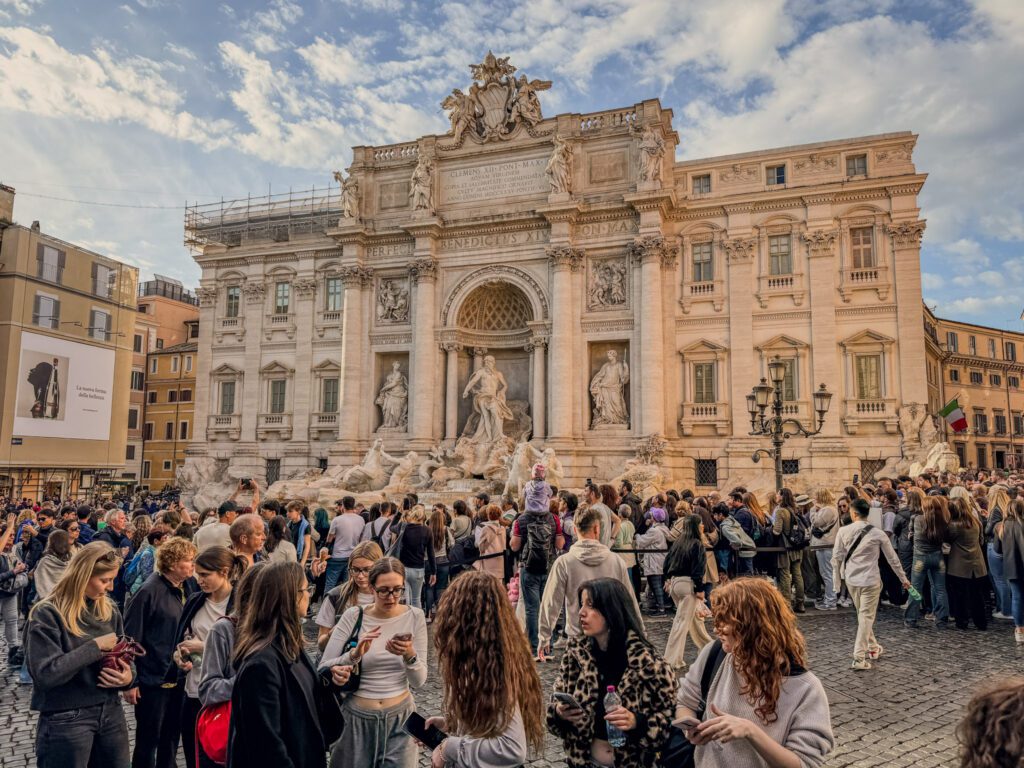
Over the course of those trips, I asked tour guides, baristas, and anyone else that would put up with broken Italian and switching over to English about the crowds, and every single one of them said that over the past two years it was the most tourists they’d ever seen (depending on their work, they all had slightly different takes on whether this was a good or bad thing).
Before those two trips, our previous trip to Rome was in the fall of 2021, when we spent a full 10 days exploring the city.
As you might imagine, the crowds at that point were very low (we were often the only Americans on tours, which meant that we got an awful lot of private tours that were supposed to be group tours).
It was a magical time to be in Europe – truly once in a lifetime for many reasons – and we will treasure those memories forever.
Those days are over, and the crowds are back. It is particularly evident at the major tourist attractions – the Colosseum and the Uffizi Gallery – and in the historic center of cities at places like Trevi Fountain and Piazza del Duomo.
The question is what can you do about it.
The answer includes three things that will help manage your experience. But before those three things, the first thing to do is manage your expectations.
If you’re coming to Italy between April and October, you’re there during the high season, and there are going to be crowds.
The idealistic experience of marveling at the Sistine Chapel alone in quiet contemplation just does not exist at this point in time for most people.
Now, here are three things you can do to avoid crowds, to the extent that it is possible.
- Walk historic centers before 8am or after 10pm (ish)
- Pre-book main attractions to avoid missing out on experiences.
- Book tours that offer off peak times (early morning or night tours)
Don’t Try to Cover Too Much Ground
As a former “pack in as many different cities as possible” traveler, I absolutely understand the instinct to try to pack in as much as humanly possible. Especially if you’re coming from a long way away, like from the United States.
However, over the past few years, we’ve really come around to the belief that slower (not necessarily “slow travel” as it’s usually talked about, because your PTO isn’t unlimited) travel is almost always the way to go.
Spending more time in a place always leads to a deeper, richer experience that will be far more memorable than spending a day in a city running around to check off all of the sights.
There are many reasons for this belief, but there are two big ones that have the biggest impact on how enjoyable your trip is going to be.
First, by spending more time in fewer cities, you’re going to be able to get a level or two deeper than most, which gives you more flexibility in terms of what you’re able to do and see, and (most importantly to us) how many meals you have.
Second, you’re going to lose significantly less time to travel. Think about it this way; every time you move cities, you have to pack up your stuff, travel to the train station (or airport), take the train, travel from the train station to your accommodations, and wait for check-in time.
Generally, you’re looking at a half day of travel time every time you move, which means if you have 10 days, and try to stay in four different cities, you’re losing about a day and a half – that’s roughly 15% of your trip – to moving around.
Instead of trying to fit more cities into your itinerary, we’d strongly recommend spending more time in fewer cities and taking advantage of day trips from there to cover more ground.
Find the Right Balance Between Cities and Smaller Towns
One of the most important pieces of planning your trip to Italy is going to be choosing which places make it onto your itinerary.
There are many different versions of Italy – the chaos of Rome, the serenity of Venice in the early morning, sunset from a hill in rural Tuscany – and your first job is going to be deciding what the balance between Italy’s bigger cities and its smaller towns looks like.
To keep things relatively simple on your first foray into Italy, we usually recommend staying in big cities where transportation links are easy and you don’t need to rent a car, and using day trips from those cities to get to the smaller towns and cities.
However, it’s also true that many of our favorite places in Italy are actually mid-sized cities like Bologna and Verona, where there is plenty to do and see, but it’s not nearly as crowded and chaotic as a place like Rome or Florence, which is packed with tourists every single day of the year.
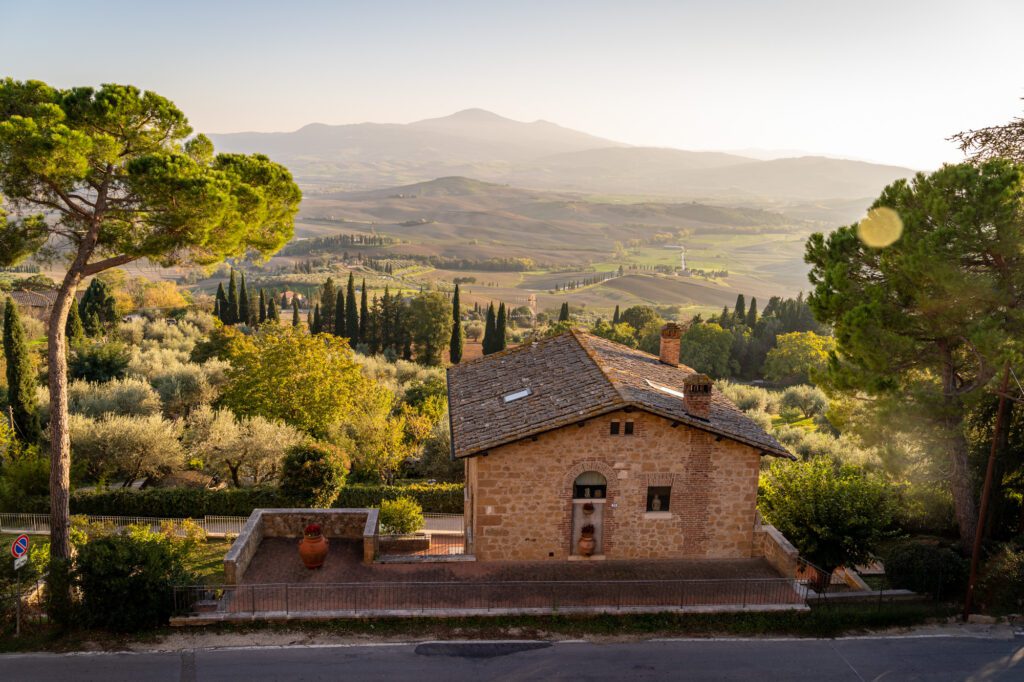
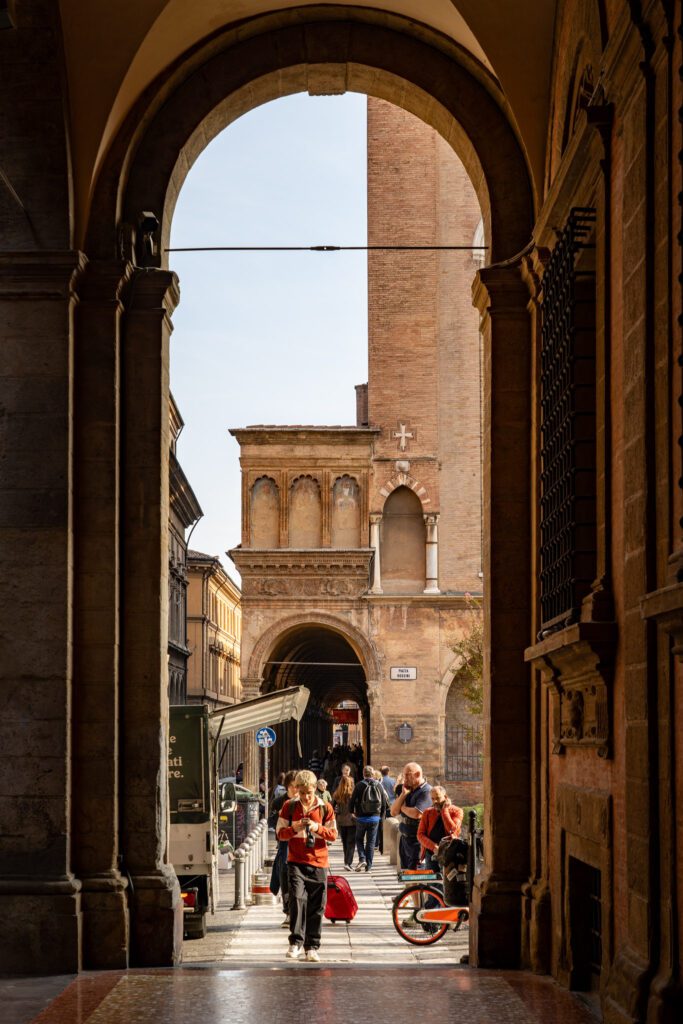
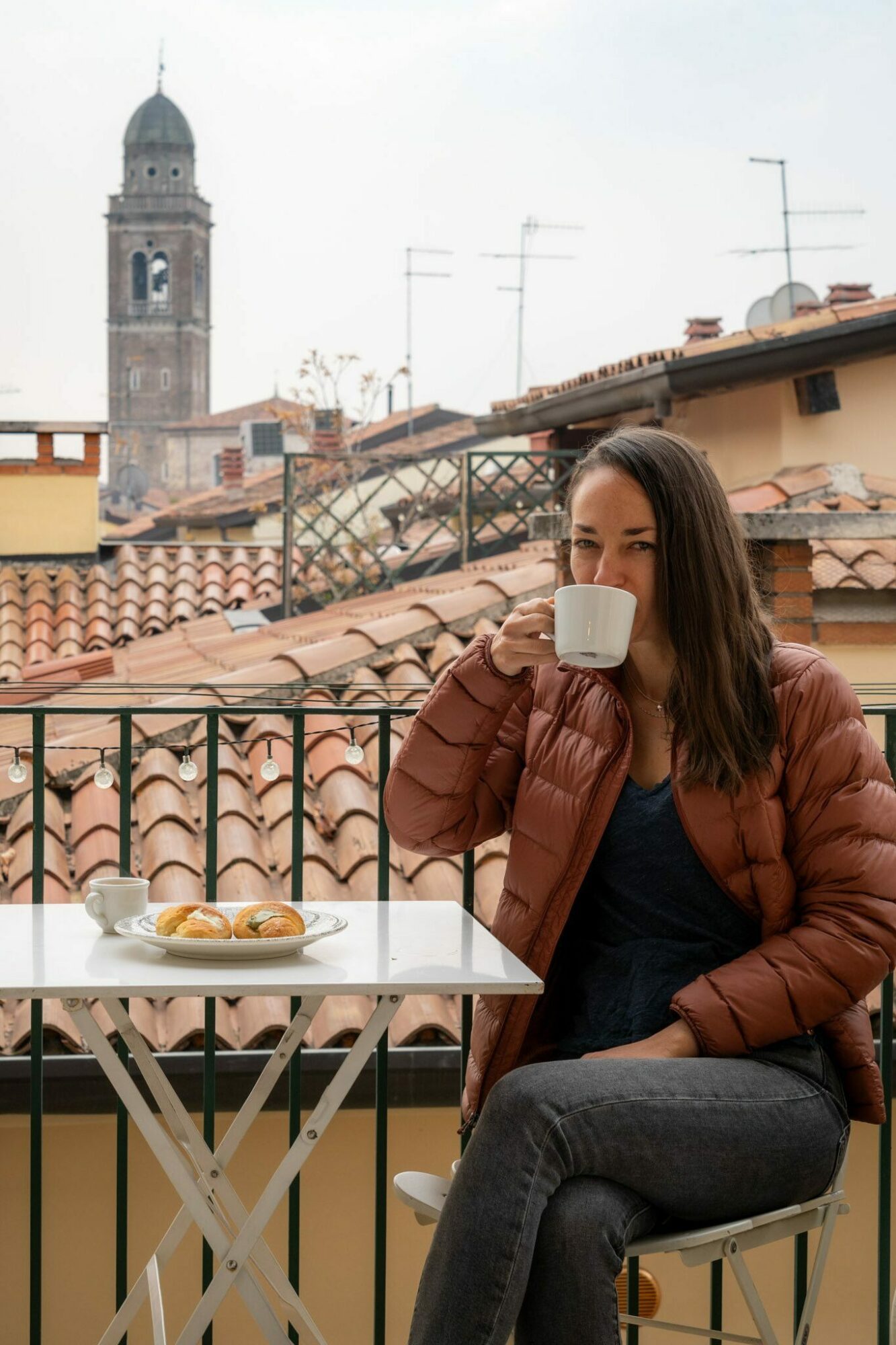
We’d recommend building time into your itinerary to get off of the Rome-Florence-Venice track for as much time as is comfortable for your particular itinerary.
For example, if you only have a week, maybe that means a day trip to Bologna from Florence (here’s our 7 day Italy itinerary for first timers).
If you have two weeks, we’d expand that to spending two nights in Bologna and doing a day trip to Verona from Venice (here’s our two week Italy itinerary that we’ve written for first time visitors).
Take Advantage of Day Trips
As we already pointed out in the section above, packing all of your stuff up every day or two is AWFUL.
It’s something we’ve learned over the past few years (from experience), and we basically try to have as few travel days as practically possible now in any itinerary we plan for ourselves.
One thing to consider if you’re wanting to see more places without the hassle and loss of time associated with moving to new accommodations is to take advantage of day trips from the main Italian cities.
By sleeping in the main city and taking the train or bus out to the day trip destination, you don’t have to do any packing AND you minimize the time lost to waiting around for checking into a new place to stay.
We would say that, generally speaking, you should choose day trips that are within 60 (90 if you’re really pushing it) minutes by train.
I, Matt, have done the Rome to Naples and Pompeii day trip before – which involves three or four hours of travel in each direction, and it’s too much to do in a day.
Almost every single city you’re likely to stay in has at least one good day trip destination within 60-90 minutes.
Some cities, like Florence, Bologna (mi amore), and Milan, have a bunch of great options to choose from for a variety of interests.
We like to save a day or two in itineraries to spend on day trips, especially from Florence, which is a great central hub for exploring some of our favorite places in Central Italy (and Pisa is not among those places, for what it’s worth – go to Lucca instead!).
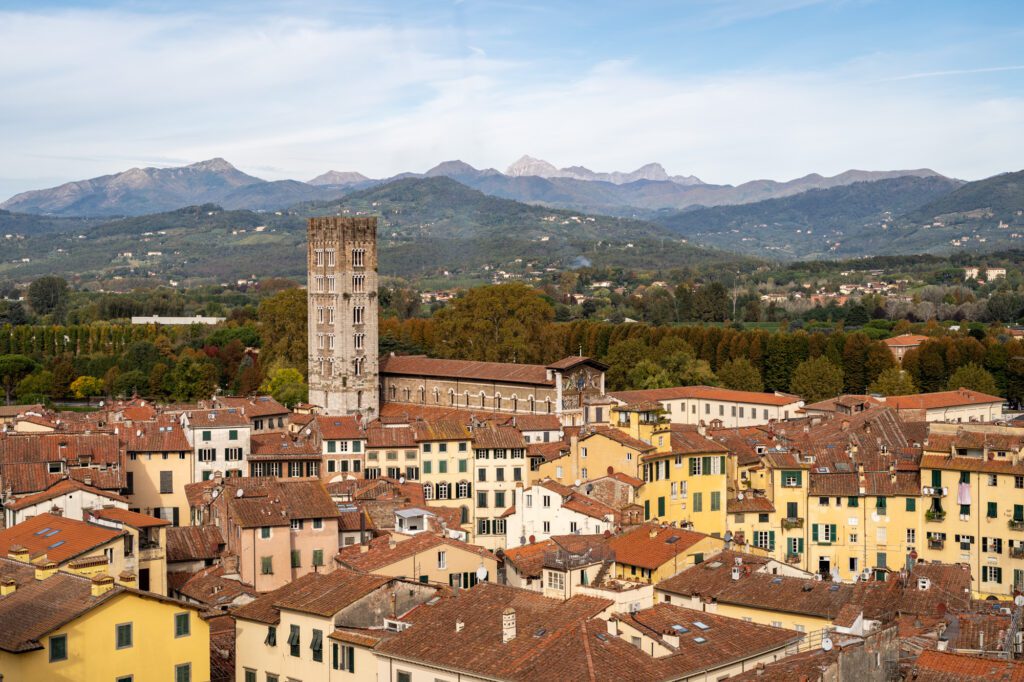
Do Not Do Multiple Big Attractions on the Same Day
I’m writing this on the afternoon after I did a morning Vatican tour (the Pristine Sistine tour with Walks of Italy, my favorite tour company in Italy!), and my brain is absolutely fried to the point where I’m jotting down half coherent notes about the tour before I forget the details, and then I’m going to try to take a nap.
I cannot even imagine what it would be like to have done that tour either before or after visiting another similarly dense tourist attraction.
Let’s take Rome as an example here.
I would absolutely make sure to split up the Colosseum and Vatican so that you’re doing them on separate days, leaving the rest of the day open for wandering a neighborhood, doing a food tour, or taking a nap to recharge.
Both the Colosseum and Vatican Museums + St. Peter’s Basilica are packed with history and culture, and a visit to either of them will sap your energy for different reasons. The Vatican because there is SO MUCH to see, the Colosseum (and Forum) because you’re outside with no shade.
My number one piece of advice for you around how to schedule your time in a city is to do major tourist attractions on separate days. That will help you absorb the information rather than being a zombie for the second attraction of the day.
This is also a big reason why three days is the minimum we recommend for Rome, Florence, and Venice – it will give you plenty of time to split the big museums and historical sights up and do them on different days.
Getting Between Cities by Train is the Way to Go
Look, we know it’s weird if you’re coming from an American context, but the train network in Italy is excellent (relative to the US) and is, by far, the most pleasant and efficient method of traveling between cities.
Unlike, say, Colombia, where flying is the most efficient and convenient way to get around because the alternative is a long winding bus ride through the mountains, the train network in Italy is the best way to travel between cities.
A lot of people ask about flying between cities and we always say the same thing: trains are better than planes in every single way we can think of.
To name a few:
- Trains have plenty of luggage storage in each car (no need to check a bag and wait for it at baggage claim)
- You can show up 15 minutes before the train leaves and be absolutely fine
- Train stations tend to be in central areas that are either within walking distance of your accommodations or a short transit/taxi ride (depending on where you’re staying and what city we’re talking about).
The exception is if you’re going from northern or central Italy to Sicily. If that’s the case, we’d fly because otherwise you have to go on a long train journey and then take a long ferry ride, and flying is going to be a more efficient use of your time.
The other alternative to trains that people usually ask about is renting a car. Let me tell you from experience that driving in Italy’s big cities is a nightmare.
Between the ZTL’s (areas where you’re not allowed to go unless you have a special permit otherwise you get a fine that is issued by cameras), dealing with Italian drivers, and driving through a crowd of pedestrians, it’s not fun.
If it’s your first trip to Italy, we’d strongly recommend avoiding renting a car and driving if you can, particularly in cities like Rome, Florence, and Venice (and similar sized cities) where the car will be more of a pain than a help.
The exception would be if you want to see a place like Tuscany or Sicily, where a car is probably necessary to get the most out of your visit.
Take the train. We love train travel, and think you will too.
Book High Speed Train Tickets in Advance
There are two levels of train in Italy; the high speed rail network that connects major cities, and the slower regional train network that connects the smaller towns and cities.
For the long journeys – like, say, Rome to Florence, Venice to Milan, etc – you’ll want to choose high speed trains to maximize your time.
These run along main routes, usually between Naples and either Milan or Venice, and are generally called “Intercity” or “Frecciarossa” trains and are operated by either Trenitalia or Italo.
For your purposes, the two operators (Trenitalia and Italo) are functionally the same (as long as you’re comparing the same cabin level), and the decision should come down to the schedule and price that fits best for your trip.
The thing about the high speed trains is that you can often save upwards of 50% by booking in advance (exactly how far in advance is anyone’s guess, though I’ve had success with booking 2-3 months out and saving a LOT).
Ticket prices are similar to airline prices – the closer to your trip you’re booking, the more expensive it’s going to be.
There is, of course, a tradeoff at play here.
By booking that far in advance, you’re sacrificing on flexibility, especially considering that many of the super cheap discount fares are completely nonrefundable, which means you’re locked into that specific train.
Whether that sacrifice is worth it or not is a personal choice. You’ll pay a bit extra for a refundable and changeable ticket, which might be worth it in case things go wrong for some reason. Either way, read the terms of the ticket you’re buying carefully.
For the slower, regional trains – which you’re most likely to encounter if you’re heading off of the Naples to Milan / Venice route – can be booked on the day of, as there’s no price difference between booking in advance and booking at the station.
There are no seat assignments, they stop more often, and they’re cheap.
The Dreaded Early Morning Airport Journey
This is both the bane of my existence as a traveler and also one of the most common questions I get, both when I’m traveling and mention that I’m a travel writer and through emails from my newsletter subscribers planning their first European trip.
“How Do I Get to the Airport for my 7am Flight?”
Because many trans-Atlantic flights heading back to the US leave at around 10:30am AND there aren’t many options leaving from Italy, you’ll likely need to make a connection somewhere else in Europe (Paris, Amsterdam, and London are the common ones).
That means that, in order to have enough time to make that connection, you’re looking at a 7am (or earlier) flight out of Italy.
Which means arriving at the airport no later than 90 minutes before takeoff (I’d highly recommend longer if you’re checking bags, because it can be a hot mess).
Getting a ride to the airport at that hour is something you need to plan for in advance. The public transportation options won’t be running (most likely) and the taxi stands will probably be sparsely populated.
Your only choice, really, is having someone pick you up and drive you to the airport.
My suggestion, and what I always do, is to either ask your accommodations to help you pre-book a taxi to the airport at least 24 hours in advance OR to use an app like Uber or FreeNow to pre-book a rideshare to the airport.
Be Prepared to Carry Your Luggage
Make sure you’re prepared for this all-too-common scenario (I’ve had to do this, but not for a long time!): dragging your luggage along a rough cobblestone street at 4:30 in the morning.
But the bigger point here is that you should be prepared for the fact that the infrastructure in Italy might be a little less forgiving than what you have at home, and there will likely be at least one time on your trip where you will have to drag your luggage up a set of stairs at a train station or along a cobblestone street to your hotel.
A few years ago, my brother and I took my mom to Italy for her 60th birthday and she ended up bringing a HUGE suitcase.
I’ll give you one guess who ended up having to haul that thing up the stairs at train stations and up the hill in Cinque Terre.
I would strongly recommend packing into one bigger bag and one smaller backpack so that you don’t have too much to keep track of and carry, but obviously that depends on who you’re traveling with (e.g. kids mean more stuff) and your particular situation.
In this section, let’s cover some of the cultural quirks about visiting Italy for the first time that would be better to know going in so that your expectations are set correctly.
Many of the negative things I hear about Italy revolve around the service being “worse” than it is “at home.”
Usually, this is coming from Americans, and it’s worth remembering that the incentive structures for servers or baristas in Italy and the US are set up completely differently. And it’s mainly driven by one factor (tipping) which we’ll get to below.
This is almost always a case of mismatched expectations, and we’re going to use this section to help set your expectations.
Service is certainly different in Italy – more passive, less cheery – but we’d reiterate something that we find ourselves saying often: “different” does not necessarily mean “worse.” In some ways, it’s nice to be left alone while you’re eating and enjoying some Italian wine.
However, it does mean that you should be aware of the slight differences and be prepared to navigate them, which is what this section is for!
We’re going to cover some of the cultural quirks that we’ve come across so that you’re aware of them and prepared to navigate them when they (inevitably) come up.
Note that we’re American, so we’re coming from that specific context and some of these differences may or may not be true with wherever home is for you.
Learn Some Basic Words and Phrases in Italian
I might be in the minority here, but I ALWAYS try to learn a few key words and phrases in the local language when I’m traveling.
Now, places like Rome, Florence, and Venice are huge tourist destinations, which means that the majority of people in the hospitality industry speak English (not as well as, say, Amsterdam, but still fairly well compared to more rural parts of Italy).
But making an effort to speak the language almost always leads to a more friendly, warm experience in just about every imaginable situation, from greeting tour guides to ordering gelato.
Speaking of gelato, allow me to use an example that I encountered on my last night in Rome on my latest trip.
It’s important to note here that I do speak a very little bit of bad Italian (thanks to my Spanish and French), and I can order food or gelato entirely in Italian. However, the principle is clear here.
I was at my favorite gelato shop in Rome (more on this in a second) on my last night to end the trip on a high note. In front of me were two Brits deciding what flavors they wanted.
They never greeted the man behind the counter, and never made eye contact until they were ready to order.
They then spoke in English, asking for a cup or cone and whatever flavors they wanted by pointing and asking for them in English.
The older Italian gentleman was surly and spoke very few words back to them, giving them their gelato and change with about as little emotion as is humanly possible.
I’m sure when he looked up to see me, an American-looking person, he was less than thrilled. But when I greeted him in Italian and asked him how he was doing, he lit up in a remarkable and unexpected transformation.
I even got a mini-Italian lesson on how to pronounce words with various combinations of c’s in Italian from another patron in the shop (who is an Italian teacher).
The point is this: a little bit of effort to learn a few key words and phrases in Italian is going to pay off 100x.
Here are the words and phrases I would learn (and their Italian counterparts with a little pronunciation guide).
- Hello – “buongiorno” (bone-jore-no) if it’s before 1-2pm, “buonasera” (bwone-ah-sarah) if it’s after 1-2pm
- Please – “per favore” (pair fah-vore-ay)
- Thank you – “grazie” (grah-zee-eh, though the last syllable changes depending on where in Italy you are)
- Goodbye – “ciao” (chow, but it’s better if you say it twice in a row!)
- Do you speak English? – “Parla Inglese?” (Par-lah Een-glay-zay)
- The bill/check please – “Il conto, per favore” (eel cone-tow pair fah-vore-ay)
- Where is XXX – “Dov’è XXX” (dough vay XXX)
- I would like XXX / We would like XXX – “Vorrei / Vorremmo” (Vore-ay / Vore-ay-moe)
An important note: The correct pronunciation of “thank you” in Italian, which is spelled “grazie”, is “grah-zee-ay.” Many people, my mom included, say something like “grah-zee” and dump the last syllable, which is incorrect and will make you sound like you watched the Godfather one too many times before your trip.
You Need to Be Assertive with Servers (Ask for the Check)
This is another difference that often befuddles Americans, and I’ve found that it really just comes down to mismatched expectations.
I vividly recall sitting at a gluten free restaurant on Campo de’ Fiori and watching several tables of Americans around me finish their food and look around expectantly, waiting for a server to stop by and ask if they were ready for the check.
Meanwhile, the servers were alternating between doing their job and standing around chatting amongst themselves while the diners got more and more visibly frustrated.
But the one thing they never did was make eye contact and ask for the check! In fact, I actually told one of the tables who seemed to be getting more and more agitated to make eye contact with the server and make the universal “signing the check” symbol if they wanted to pay.
Miraculously, as soon as they did that, the server brought over the check and the card reader and they were off a few minutes later.
Here’s the thing. In the US, waiters are often ALL OVER you, asking if you’re ready to order, asking if you need anything else, refilling water, etc etc.
There’s a very good and very practical reason for this (aside from cultural differences): tipping.
We’ll cover tipping in a second (spoiler: it’s complicated), but the gist is this: servers in the US are often paid less than minimum wage as a base salary, and they make most of their money with tips.
Without making a judgment on how good this system is (okay I’ll bite, it’s terrible and just passes the burden of paying workers from businesses to customers), the outcome of that system is that servers are incentivized to be as friendly, jovial, and helpful as possible to maximize their tips.
Spoiler alert: that friendliness and jovial nature is often more a performance than anything else.
In Italy and the rest of Europe, tips are a much smaller part of their income, so a lot of that veneer of friendliness and joviality is taken away, leaving you with practical service that basically just leaves you alone unless you tell them you need something.
The takeaway is that, in order to get what you want or need at a restaurant in Italy, you’ll need to be a little more assertive than you’re used to at home.
If you need something – including the check – you’ll need to flag down a server and ask for it.
Let’s Talk Tipping
Tipping is a complicated subject in Italy.
Like I just mentioned, servers and baristas are paid a minimum wage that’s relatively higher than here in the US (there’s no lower minimum wage for tipped employees), so they’re not as reliant on tips as they are in the US.
However, tipping is still a nice thing to do for good service, especially in a restaurant setting.
There are countless guides out there that all say different things, so I asked a couple of Italians and expats who live in Italy what they generally do.
Generally speaking, they all said basically the same thing; tipping isn’t expected, but I still do it in certain scenarios (though one of them said they flat out don’t tip).
- For coffee at the bar, which is generally around 1.20 or 1.40, leave a tip of $.10 or $.20 per drink, preferably as coins on the bar as you leave
- For table service at a coffee shop or a bar, round up to the nearest Euro
- For table service at a restaurant, especially a nicer meal, add 5-10% to the total (or round up to the nearest round number – e.g. if the bill is 31.70, round up to 35.00).
The other thing to know about tipping is that at restaurants when you pay with a card, you have to tell them what the total amount you want to pay is BEFORE you actually pay.
Which is different from how we do it in the US where you would add the tip to the receipt AFTER you pay.
For example, say your total is 31.70 again. When you ask for the check and say you want to pay with a card, the server is going to put the total into the card reader and give it to you to tap/insert your card.
There’s no way to add the tip after you pay (unless you leave cash on the table), so you’ll have to tell them you want to leave a tip BEFORE you pay, and the best way to do it is to simply just say (in the example above) “35 Euros, please” before they put in the amount to the card reader.
If you’re paying with cash, the same general principle applies.
Tell them the total amount you’d like to pay, including any tip, when you hand them the cash.
For example, if your bill is 31.70, you want the total including tip to be 35, and you’re handing over 40 in cash, you’d say “5 Euros back, please” to indicate that you want to leave that extra as a tip.
Again, worth noting that there is no expectation around tipping like there is in the U.S., but you can still tip if you feel like you had a good experience and want to thank the server/restaurant.
Public Restrooms are Either Paid or Nonexistent
Another aspect of traveling in Italy, and Europe more broadly, is the idea of paying for a public restroom. Which is very much the norm as you’re traveling around Italy.
Even at places like the train station, you’ll usually need to pay a Euro to use the restroom.
This is not true at places you’ve paid to enter – like a museum or a restaurant – but the idea of free public restrooms in a place like a mall or a train station is not something you’ll find in Italy.
Be prepared to pay to use a restroom, either by buying a coffee or pastry (or a museum ticket), or with a couple of coins at public restrooms.
Sitting at a Table Usually Costs Extra
This is a big difference between cafe culture in the US and Italy that many people don’t realize until they experience it – coffee, food, and drinks are going to cost more if you get it “for here” and sit at a table than if you get it either to go or standing at the bar.
Which is why you’ll find so many Italians crowding the bar to get a caffe rather than sitting down at a table.
To me, this actually makes sense. It costs more in labor (you need a server) to offer table service, so it makes sense that it would cost more for the customer.
But I understand how that is somewhat unexpected if you’re coming from a U.S. context.
If you’re looking to linger and stay awhile, just be aware that you’ll be paying a slightly (usually it’s only slightly) higher price.
Another thing to keep in mind is that, in some places (it varies by region and even by city) you’ll find “coperto” (in Rome, it’s usually called “servizio”) added to your bill, which is essentially a flat cover charge per person.
Usually, it’s only a couple of Euros per person, but in places like Piazza San Marco in Venice or other VERY tourist-centric places, you can see it inch up towards 10 or more Euros per person for the privilege of sitting at a table near a world-famous attraction.
Exploring Italy’s Food (and Drink) Scene
I think one of the important things to remember before you visit Italy for the first time is that Italy as we know it (a unified country) is actually a relatively new concept in the scope of history.
Depending on which part of the process of unification you use, the unification of Italy happened sometime between 1861 (when the Kingdom of Italy was proclaimed with Florence as its capital) and 1871 (when Rome was brought into the fold and became the capital).
Before that – between the time of the Roman Empire and the 19th Century – the Italian peninsula was broken up into a series of independent city states and republics, some of which were controlled by bigger European powers like the Austrians or French (or even the Catholic Church – the Papal States were the last territory to stand against unification).
The fact that Italy is a relatively new concept means that each region is intensely regional, from linguistics (like accents and slang), to industries, to, of course, typical foods and drinks.
In this section, let’s talk about Italian food (and most importantly, that there’s really no such thing as “Italian food” because it changes so much from region to region).
“Italian Food” Isn’t a Thing – Each Region Has a Unique Food Culture
If there’s one thing you take away from this section on food in Italy (or even from this guide as a whole), it’s that you should treat each region in Italy that you visit almost like you’re in a different country in the sense that what you eat and drink should change as you move around Italy.
For example, what you should eat in Rome (the Roman pastas like carbonara and alla gricia, pizza al taglio, and carcioffi alla Romana) and what you should eat in Venice (seppie alla veneziana and pasta alla busara) are completely different.
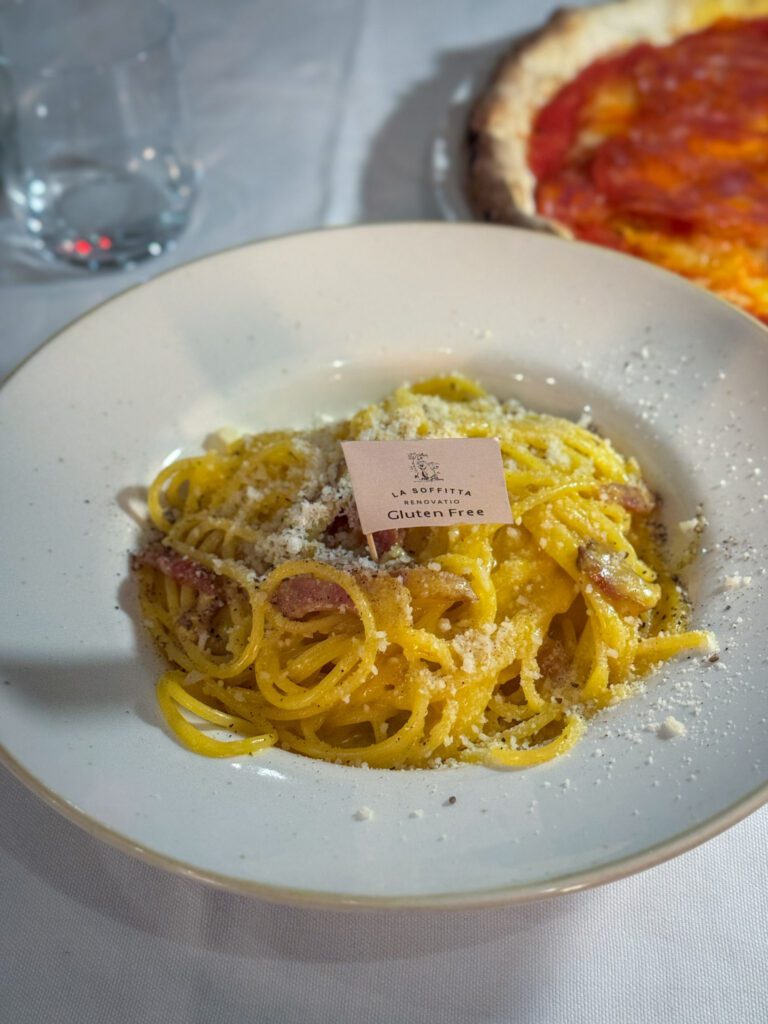
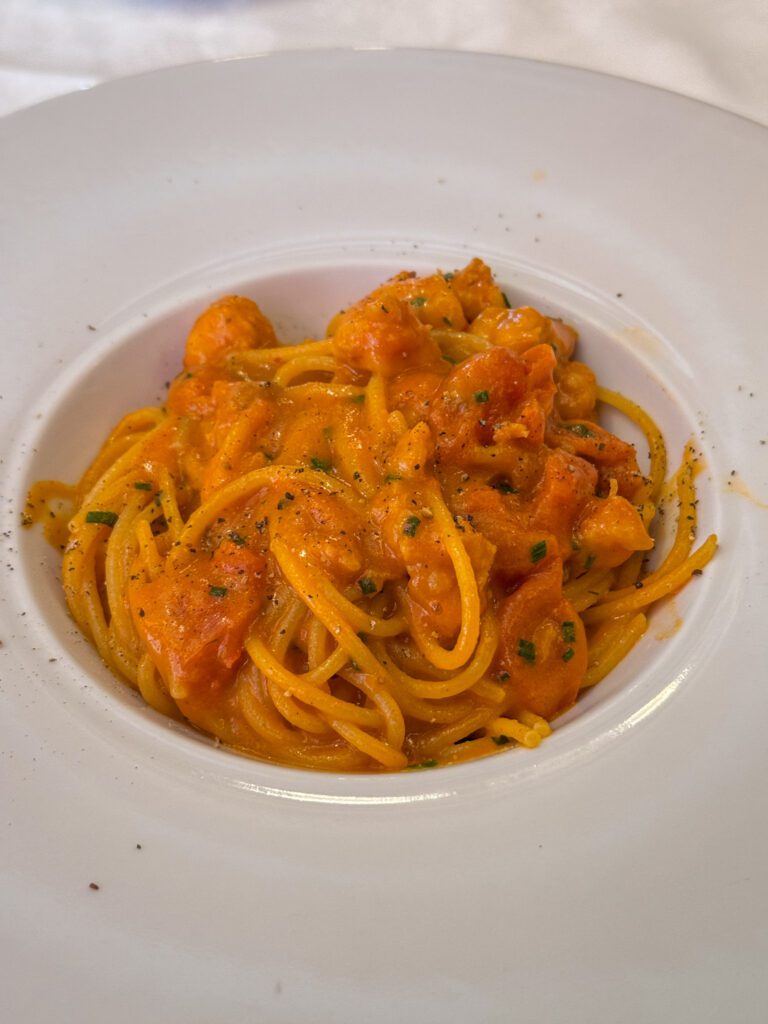
Which makes sense, because the ingredients that you find in those two places are completely different based on their geography.
The biggest tip I can give you about how to figure out what / where to eat in each place is to put in the legwork and do some research.
It can be as simple as searching “what to eat in Venice” and reading through a Venetian’s blog post or a Reddit thread, or it could be some deeper research by watching a travel show, listening to a podcast, or reading a book about it.
Italian Food and Italian-American Food Are Completely Different
One of the main criticisms I hear about the food in Italy, either by reading about people’s experiences or from people who email me, is that it’s not the same as the food they get at home.
Which is… absolutely true.
Italian-American food is almost a completely separate cuisine than regional Italian food.
For example, a few years ago I was deep into a “Roman pasta” phase where I was buying guanciale and pecorino romano by the pound and making a lot of carbonara.
During that phase, we went to Boston and went out to a restaurant in the North End (Boston’s Little Italy) known for authentic Italian food.
I saw carbonara on the menu and, of course, being deep into making carbonara myself, I ordered it.
To my horror, they used HEAVY CREAM in their carbonara. Which would absolutely make every Roman nonna roll over in their grave (along with cutting your spaghetti).
I knew from a lot of reading and listening to Roman food personalities talk about carbonara that the secret to a creamy carbonara is the mixture of warm pasta water, egg, and pecorino – NOT heavy cream.
But Italian-American food comes from a different context, so of course it’s going to look different.
The American palate is more used to rich foods and Italian-American food has risen to the occasion.
My point here is to remember that they’re different – don’t expect to find the classics from your favorite Italian restaurant at home in Italy – and if you find things like fettuccine alfredo or chicken parmigiana on a menu in Italy, you should probably eat elsewhere.
Avoid Restaurants with Pictures on the Menu OR a Salesperson Outside
This is a good rule to live by in any city, and is a very common occurrence in places like Rome and Florence’s historic centers.
You’ll be walking down a street lined with restaurants, and there will be a big cardboard menu outside covered in pictures with a couple of servers whose job is to lure you in for a meal.
Don’t do it. That’s the tip here.
Again, rather than walking around in a place full of tourists and choosing a place based on vibes, seek out experts who can help you find a place to eat that is going to give you a real taste of the food that you’re looking to experience.
You’re Going to Pay for Water at Restaurants
This is another little quirk that you should know before you go to Italy (or France, or Spain…etc etc); free tap water at a restaurant is not something that is generally available.
In fact, many places simply will not give it to you even if you ask for it.
Instead, if you want water with your meal, you’ll need to buy a bottle of water. Just accept it as a fact and go with it.
You can choose between still (acqua minerale) and sparkling (acqua frizzante), and they both usually cost about the same (a couple of Euros for a bigger bottle).
We’d also add to this that you’re very unlikely to find ice to put in your water.
It’s just not a thing that people in Italy (or most other places in Europe) do, and they don’t have the infrastructure (ice machines, mostly) to offer it to you.
Drink the Local Wine
Similar to food, wine is also intensely regionalized in Italy which, again, makes total sense when you think about the context of Italy as a series of independent republics and city states over the past 1,000 years or so.
For a combination of many reasons, Italian wine just hits differently than wine from the new world.
My somewhat educated opinion is that it’s roughly equal parts centuries of farming and winemaking expertise and the fact that you’re on vacation, so everything just tastes a little bit better.

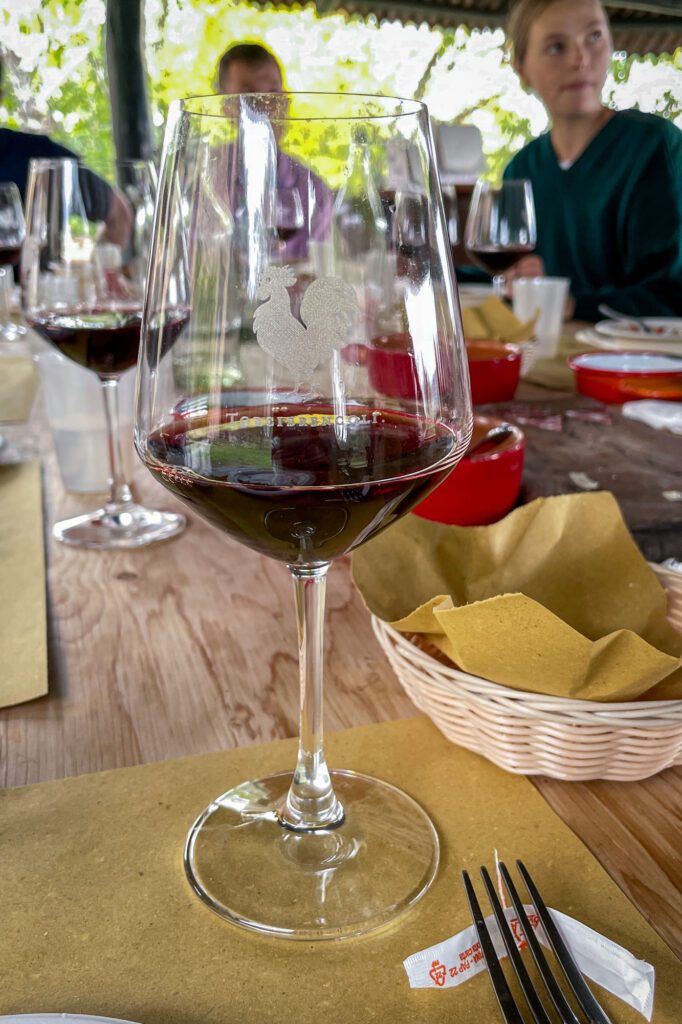
There are somewhere around 320-350 different wine varieties in Italy, and as you move from region to region, the wines you’re likely to encounter are going to change.
In most places, especially places that see a lot of tourists, you’re likely to encounter wines like pinot grigio and prosecco whether or not you’re in the place where those wines are made.
While those wines are great, I’d make it a priority to try a wine or two in each region that you’re unfamiliar with (and the best way to find them is to ask servers for help, particularly at wine bars).
Another tip here: The house wine in Italy (“vino della casa”) is almost always somewhere between “fine” and “really good” ESPECIALLY when you consider the price (a few Euros a glass). We’re always surprised at how good the house wine is when we’re in Italy, and we wouldn’t shy away from ordering it (in fact, we’d encourage it).
Bring a Reusable Water Bottle to Refill
This is true for just about every destination around the world, but you should absolutely bring a reusable water bottle to refill rather than buying a bunch of plastic water bottles over the course of your trip.
Tap water in Italy is safe to drink, and Rome actually has a bunch of cool old water fountains around the city that are safe to drink from (and refill your bottle) that even offer sparkling water. For free!
There’s one near the Colosseum (on the southwest side of the square near the Arch of Constantine) that we went to multiple times.
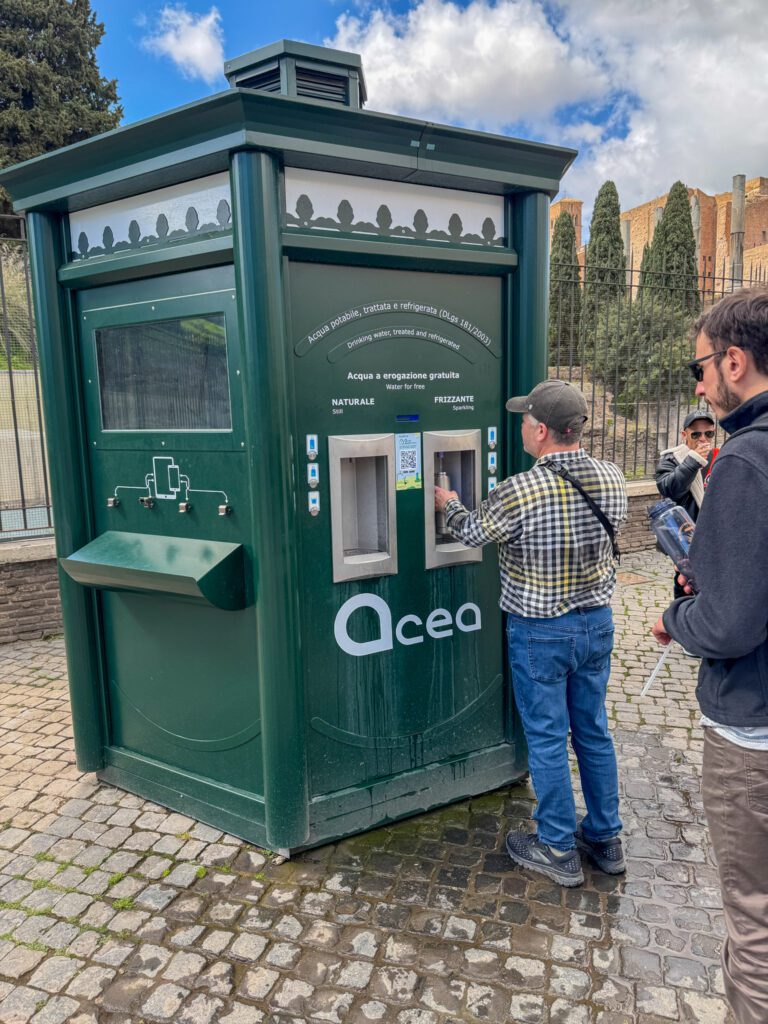
Embrace the “Caffe e Cornetto” of it All
As a general rule, Italians don’t buy the whole “breakfast is the most important meal of the day” nonsense that has been drilled into Americans since we were toddlers (thanks, multinational cereal conglomerates).
In fact, the only places I’ve really seen breakfast are at either hotels (that cater to tourists), restaurants near tourist attractions like the Colosseum and Vatican (that cater to tourists), and hipster brunch restaurants (that cater to tourists).
Instead, many Italians start their day with a coffee, a pastry (the cornetto / brioche, which is similar to a croissant, is a common choice), and sometimes a cigarette. And they usually do it standing at the bar.
When in Rome, right? We’re not huge breakfast people anyway, so we fully embrace the caffe e cornetto lifestyle when we’re in Italy (though, Matt can’t really do the cornetto most places, so it’s just caffe I guess).
Don’t Eat Within a Few Blocks of the Major Attractions
This is a good general rule to follow almost anywhere in the world, but it’s particularly relevant in Italy where you have some of the most visited tourist attractions in the world like the Colosseum, Vatican, and Piazza San Marco.
Generally speaking, the quality of food that you find near those major tourist attractions is going to be worse, AND the price is going to be higher (sometimes you even get an added cover charge for the location).
Plus, the menus in those places are going to skew towards catering to the palate of visitors rather than locals, which means you’re missing out on the local specialties that make each region unique (we sort of covered this above).
Those restaurants are seeing a steady stream of people day in and day out, and there’s no real incentive for them to serve great food because they don’t really need to.
If we were you, we’d avoid eating within a few blocks of any of the major tourist attractions in Italy (with only a few exceptions).
With all that said, we would also say that there is something special about enjoying a coffee or spritz with a view of Piazza San Marco or the Duomo di Milano, so if that’s something you’re into, just go into it knowing that you’re going to pay a premium for a product that is probably not as good as you might find elsewhere.

Planning a trip to Italy? We’d love to help!
Here are our other Italy travel guides to help you plan an incredible trip (even if you have to eat gluten free!).
If there’s no link below, it means we’re still working on it – long, in-depth guides take time! We’re working on it, though, we promise.
If you’re planning a trip and you’re not sure where to start, your first stop should probably be one of our detailed itineraries.
We have a two week Italy itinerary that blends the main cities with some less-visited cities that we love (BOLOGNA!), a guide to spending 10 days in Italy that focuses mostly on the highlights, and a whirlwind guide to spending one week in Italy that features the Rome – Florence – Venice highlight circuit.
We also have a guide covering important tips for traveling to Italy for the first time, which is a collection of things we’ve learned over the course of our time in Italy that will help you have a smoother, more immersive trip.
Here are more specific guides to the main cities in Italy.
Rome
- What to do in Rome (as a First Timer)
- How to Plan an Amazing 4 Day Rome Itinerary
- Where to Stay in Rome: A Complete Guide for First Timers
- 26 Things to Know Before You Visit Rome
- Gluten Free Rome: A Complete Guide to GF Restaurants + Bakeries
- Where to Find the Best Specialty Coffee in Rome
Florence
- What to do in Florence (as a First Timer)
- How to Plan an Amazing Florence Itinerary (3 Days)
- Where to Stay in Florence: A Complete Guide for First Timers
- Gluten Free Florence: A Complete Guide to GF Restaurants + Bakeries
- Where to Find the Best Specialty Coffee in Florence (for Coffee Nerds)
- The Best Day Trips from Florence (Complete Planning Guide)
Venice
- A Perfect 3 Day Venice Itinerary (for First Timers)
- Exactly What to Do in Venice (As a First Timer)
- Where to Stay in Venice: A Complete Guide
- Gluten Free Venice: A Complete Guide (for Foodies)
Bologna
- What to do in Bologna (as a First Timer)
- How to Spend One Incredible Day in Bologna
- How to Plan an Amazing Bologna Itinerary (2 Days)
- Where to Stay in Bologna: A Complete Guide for First Timers
Cinque Terre
- What to do in Cinque Terre (as a First Timer)
- How to Plan an Amazing Cinque Terre Itinerary (2 Days)
- Where to Stay in Cinque Terre: A Complete Guide for First Timers
Milan
- What to do in Milan (as a First Timer)
- How to Plan an Amazing Milan Itinerary (2 Days)
- Where to Stay in Milan: A Complete Guide for First Timers
- Gluten Free Milan: A Complete Guide to GF Restaurants + Bakeries
The Rest of Italy
